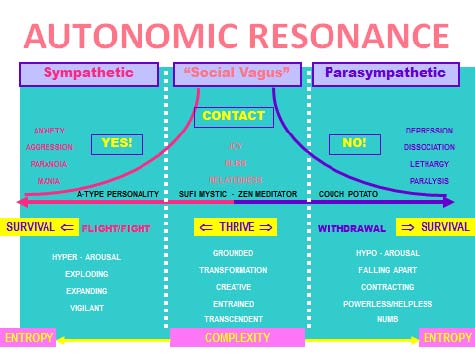How to Make Friends and Keep Them
Safe interpersonal connection and social interaction is the essence of any therapeutic and medical communication. More importantly, it is also the essence of all human interaction! Your business deals, your marriage, your social life, the connection with your kids, even your ability to play sports are based on a very complex set of brain-body interactions. They are hardwired into us and – from the background - govern every aspect of our social behavior.
This month my class will focus our conversation on social engagement and “how to make friends and keep them”. You will learn why having great interpersonal rapport is good for you and your overall health.
Social Engagement: Reading Faces and Showing Feelings
We will discuss the role of something I call the “Social Engagement System”. The correct name  for this is the polyvagal system. This theory describes a specific system wired into our brain that helps us to “read” people and also show them how we feel. We recognize facial mimicry, track someone’s posture, and react to someone’s tone of voice to help us decide if we will be safe or sorry when we reach out and connect with someone.
for this is the polyvagal system. This theory describes a specific system wired into our brain that helps us to “read” people and also show them how we feel. We recognize facial mimicry, track someone’s posture, and react to someone’s tone of voice to help us decide if we will be safe or sorry when we reach out and connect with someone.
Relatively recently, it was discovered that the vagus nerve, the longest of the twelve pairs of cranial nerves that originate in the brain and part of the autonomic nervous system, also has functions in the larynx, diaphragm, heart and stomach as well as sensory functions in the ears and tongue. It connects the brain, heart and gut.
This is where neuroscientist Stephen Porges, Ph.D. focused his research. From this research he developed the Polyvagal Theory. He postulated that the vagus nerve in humans evolved to divide and create a third - more advanced – sub section of the autonomic nervous system that is concerned with social interaction.
That has become a sensation in the world of psychotherapy because it explains so many aspects of this interpersonal healing modality. It explains how relationship heals. Furthermore, it emphasizes what happens in a good doctor-patient relationship: Besides state-of-the art medical techniques a practitioner may apply, the real healing happens when a patient feels met on a deep level - through attentive listening, eye-contact, and the warmth of the tone of voice of the practitioner. These are all functions of the polyvagal system.
Why Mothers Talk Funny and Why Babies Smile…. the Polyvagal Theory in Action
The vagus nerve in humans evolved to create a third section of the autonomic nervous system set. I prefer to call this third system the social vagus (“social nervous system”), because it originates in a different part of the brain stem, and exhibits more sophisticated physiological reactions that are geared for contact and social interactions.
One familiar expression of the social nervous system is that special soothing tone of voice and cooing language mothers use to calm their children. It is popularly called "Motherese” (the scientific word is "prosody"). You have seen and felt it: Mothers make their babies smile with their “funny talk”. A voice shift can help people move into different energetic states.
Autonomic Resonance and Attunement with Another Person
Eye contact and facial expression are essential for the mother-child connection. They are non-verbal ways of expressing and tracking what is going on within the other. When a baby smiles, the mother knows it is happy. That is called Autonomic Resonance or Attunement.
When the mother frowns, the child knows that something is off and may be able to adapt its behavior so that the frown goes away and a smile appears. You can see that this important nonverbal connection can lead to difficulties if the mother is not attuned with the child. Trauma arises because of this kind of miscommunication and misattunement.
Take notice on your next phone call: You know in a second what feeling state your friend is in. Your interview performance may rapidly change if your future boss talks in a harsh voice or in a friendly soothing tone. Therapists can use vocal tones to subtly shift the atmosphere in the room. This can be in either direction; a low and gentle sound to soothe or an energized voice that helps a person to charge up and stay with the therapist.

One of the essential domains of any body-psychotherapy is the work with movement and expression. People who have come to my workshops will know that I rarely leave out music, sounding and movement in my programs. Here is why: For me, music adds spontaneity and makes it easier to move without thinking. It helps me to “get out of the head” and into the body. It facilitates letting go, which is considered to be a good thing in my trade. That alone has healing effects! Movement, sound and breathing often trigger an opening of certain pathways in our brain by directly contacting the more primal aspects of our emotional brain.
There is a neuroscience-based reason for all the moving and dancing I have my clients do! The act of making a smiling face might bring the smile back to one’s brain. Conversely, a harsh movement and an angry sound may connect you with an experience of the past where anger, or helplessness played a role. You can try this out for yourself (…but not too long!...): If you make a sad face long enough you will feel sad and depressed. Guaranteed!
Implications for Healing, Mind/Body Connection and Personal Growth
You can see the far-reaching implications and powerful consequences of this information for any form of emotional healing, mind-body medicine, psychotherapy, personal growth and any process for spiritual opening!
When I lead body-based exercises I almost always emphasize that participants put their experience into words so that they can consciously register that they have had it. Speaking the words engages the social vagus system via the facial muscles and feeds information back to the brain. This links the conscious with the not-so-conscious - awareness arises! The experience becomes part of one’s “narrative” (…as opposed to the “old” trauma narrative), one’s new story of what is real, here and now, fully felt in the body, complete with new choices for one’s life. Building one’s narrative means building one’s sense of self. And, having a secure and contiguous sense of self is a major quality of being human AND being well. It is a sign of one’s complete health, empowerment and vitality.
Adapted from a lecture delivered to the D.C. Guild of Body-Psychotherapists given by Kuno Bachbauer, MD. Report and written article by Catherine Edwards. Edited by Kuno Bachbauer, M.D. All Copy Rights Reserved © 2016
Join me for the fun, free and experiential class:
Presence, The Art of Making Contact
When: Tuesday, December 6 , 2016
Time: 6:30 p.m. - 8:00 p.m.
Where: National Integrated Health Associates
5225 Wisconsin Ave NW, Suite 402
Washington, DC 20015
Presenter: Kuno Bachbauer, LMFT
Cost: Free
Register
 Kuno Bachbauer LMFT, Graduated from University of Vienna Medical School in 1978. Unsatisfied with the scope of traditional medicine, he soon focused on exploring various personal growth methods that included both the body and spirituality. Kuno is a holistic psychotherapist and is certified in Core Energetics Evolutionary Process and on the Senior Faculty of the Institute of Core Energetics East, N.Y. He has also taught Core Energetics to students in Brazil, Mexico and Australia. He is regarded as an innovative, creative and dynamic teacher and presenter.
Kuno Bachbauer LMFT, Graduated from University of Vienna Medical School in 1978. Unsatisfied with the scope of traditional medicine, he soon focused on exploring various personal growth methods that included both the body and spirituality. Kuno is a holistic psychotherapist and is certified in Core Energetics Evolutionary Process and on the Senior Faculty of the Institute of Core Energetics East, N.Y. He has also taught Core Energetics to students in Brazil, Mexico and Australia. He is regarded as an innovative, creative and dynamic teacher and presenter.
.png?width=305&height=132&name=NIHAlogoBLUE_3_transparent%20(2).png)
